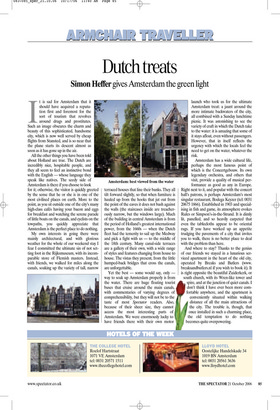Dutch treats
Simon Heffer gives Amsterdam the green light It is sad for Amsterdam that it should have acquired a reputation first and foremost for the sort of tourism that revolves around drugs and prostitutes. Such an image obscures the charm and beauty of this sophisticated, handsome city, which is now well served by cheap flights from Stansted, and is so near that the plane starts its descent almost as soon as it has gone up in the air.
All the other things you have been told about Holland are true. The Dutch are incredibly nice, hospitable people, and they all seem to feel an instinctive bond with the English — whose language they speak like natives. The seedy side of Amsterdam is there if you choose to look for it; otherwise, the visitor is quickly greeted by the sense that he or she is in one of the most civilised places on earth. More to the point, as you sit outside one of the city’s many high-class cafés having your bacon and eggs for breakfast and watching the serene parade of little boats on the canals, and cyclists on the towpaths, you quickly appreciate that Amsterdam is the perfect place to do nothing.
My own interests in going there were mainly architectural, and with glorious weather for the whole of our weekend stay I fear I committed the ultimate sin of not setting foot in the Rijksmuseum, with its incomparable store of Flemish masters. Instead, with friends, we walked for miles along the canals, soaking up the variety of tall, narrow terraced houses that line their banks. They all tilt forward slightly, so that when furniture is hauled up from the hooks that jut out from the point of the eaves it does not bash against the walls (the staircases inside are treacherously narrow, but the windows large). Much of the building in central Amsterdam is from the period of Holland’s greatest international power, from the 1660s — when the Dutch fleet had the temerity to sail up the Medway and pick a fight with us — to the middle of the 18th century. Many canal-side terraces are a gallery of their own, with a wide range of styles and features changing from house to house. The vistas they present, from the little humped-back bridges that cross the canals, are unforgettable.
Yet the best — some would say, only way to soak up Amsterdam properly is from the water. There are huge floating tourist buses that cruise around the main canals, with commentaries of varying degrees of comprehensibility, but they will not be to the taste of most Spectator readers. Also, because of their sheer size, they cannot access the most interesting parts of Amsterdam. We were enormously lucky to have friends there with their own motor launch who took us for the ultimate Amsterdam treat: a jaunt around the more intimate backwaters of the city, all combined with a Sunday lunchtime picnic. It was astonishing to see the variety of craft in which the Dutch take to the water: it is amazing that some of it stays afloat, even without passengers. However, that in itself reflects the urgency with which the locals feel the need to get on the water, whatever the risk.
Amsterdam has a wide cultural life, perhaps the most famous point of which is the Concertgebouw. Its own legendary orchestra, and others that visit, provide a quality of musical performance as good as any in Europe. Right next to it, and popular with the concert hall’s patrons, is perhaps Amsterdam’s most singular restaurant, Bodega Keyzer (tel: 0031 20675 1866). Established in 1903 and specialising in fish and game, its atmosphere evokes Rules or Simpson’s-in-the-Strand. It is dimly lit, panelled, and so heavily carpeted that even the tablecloths appear to be oriental rugs. If you have worked up an appetite trudging the pavements of a city that invites you to walk, there is no better place to deal with the problem than here.
And where to stay? Thanks to the genius of our friends we stayed in a luxurious serviced apartment in the heart of the old city, operated by Breaks and Butlers (www. breaksandbutlers.nl if you wish to book it). It is right opposite the beautiful Zuiderkerk, or south church, with its Wren-like tower and spire, and at the junction of quiet canals. I don’t think I have ever been more comfortable anywhere, and the apartment is conveniently situated within walking distance of all the main attractions of the city. The trouble is, though, that once installed in such a charming place, the old temptation to do nothing becomes quite overpowering.


































































































 Previous page
Previous page